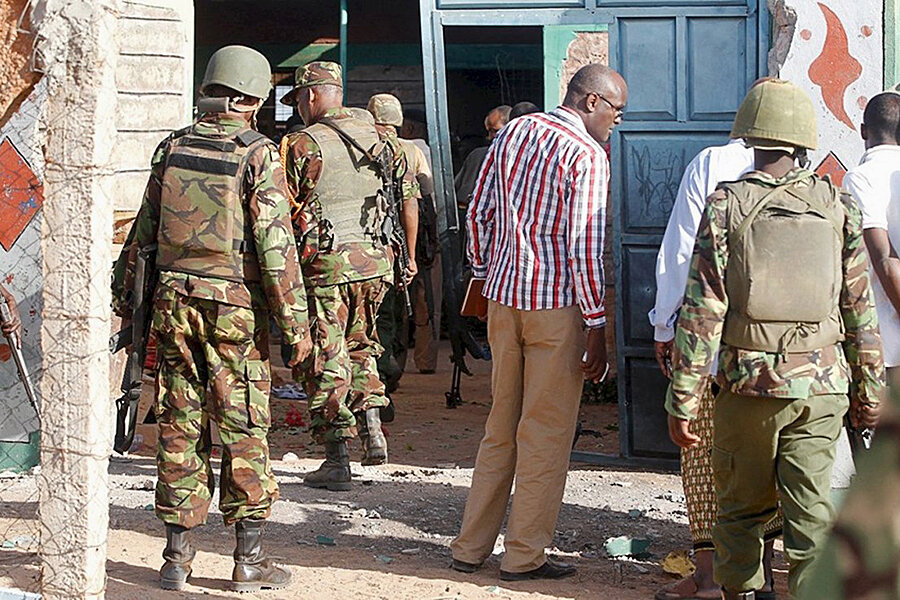Al Shabab attack in northeast Kenya is deadliest since university massacre
Loading...
Al Shabab militants killed fourteen people Tuesday in northeast Kenya, raising questions about Kenya’s capacity to respond to the Islamist group just weeks before a state visit by President Obama.
The gun and grenade attack took place at 2 a.m. at a residential complex for miners in the remote town of Soko Mbuzi in Mandera county, close to the Somali border, Reuters reports. Christians appear to have been the main target, similar to an attack in the same area last December where 36 mostly Christian miners were murdered.
“All indications are that they were al-Shabab militants. They destroyed metal grilled doors before they bombed the houses and opened fire on the innocent victims,” the county commissioner, Alex Ole Nkoyo, told the Standard newspaper in Nairobi. Eleven people were injured.
Somalia-based Al Shabab quickly claimed responsibility. Sheikh Abdiaziz Abu Musab, Al Shabab's military operations spokesman, speaking on the group's main broadcaster, Radio Andalus, also said the killing was part of its Ramadan campaign against Kenya.
The attack comes three months after Al Shabab massacred 148 students at a university in Garissa, an attack seen as retribution campaign for Kenya's military intervention in Somalia. Kenya sent its troops to Somalia in October 2011 following a series of cross-border attacks by militants.
The group continues to attack towns in northern Kenya, highlighting the vulnerability of the border with Somalia, the Monitor reported in April:
Somalia-based Al Shabab has been a constant threat in the three counties that sit on Kenya’s eastern border with Somalia, but most of its attacks have been outside major population centers. That has made the assault on the university in Garissa particularly jarring – not only because the town is home to both military barracks and police headquarters, but because it followed high-profile warnings about a threat to a “major university.”
For Kenya, this latest attack underscores one of the key hurdles to curbing threats from Al Shabab: the porosity of the border between Somalia and Kenya's Mandera, Wajir, and Garissa counties. And it may increase pressure to take more assertive steps to close the gaps in a sparsely populated and lightly patrolled region.
“They don’t have the capacity to protect all the targets. This is why they need to close the border,” says Andrew Franklin, a Nairobi-based security analyst who has long argued for the construction of a wall along the entirety of the border with Somalia. Last month, Kenya announced plans to build a wall along the border between Mandera and Somalia.
Security remain a top priority for Kenya, especially with President Obama’s visit at the end of July. The Guardian reports that “there are concerns militants could take advantage of the occasion to stage attacks.” The US is co-hosting the 2015 Global Entrepreneurship Summit and thousands are expected to attend.
Obama's security detail is sure to be tight, Foreign Policy reports, pointing that security for Obama's 2013 trip to Senegal, South Africa and Tanzania cost between $60 million and $100 million.
With the attacks expected to continue, especially after the massacre in Garissa, many Kenyans have questioned the country’s involvement in Somalia, “ending decades of relative neutrality," the Monitor reported.
“This intervention was sold on the fact that it would make Kenya safer. Whatever true intentions may have been – and there are many – it was sold as basically that we were going to protect ourselves,” says Cedric Barnes, Nairobi-based Horn of Africa project director for International Crisis Group.
But today, Kenyans do not feel any safer. In October 2011, 26 percent of Kenyans said an increase in attacks was more likely as a result of the intervention, according to surveys by Ipsos Kenya. By December 2014, that had climbed to 55 percent.
Behind this fear is Al Shabab. Since 2013, it has attacked Kenya 63 times, according to data as of late April from the Washington-based Foundation for the Defense of Democracies. Slightly more than half of the 63 attacks in Kenya occurred in just Garissa, Wajir, and Mandera counties. Most of the rest occurred on the coast.







